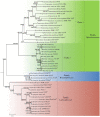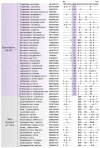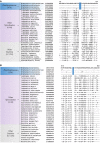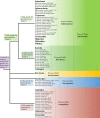A phylogenomic and molecular signature based approach for characterization of the phylum Spirochaetes and its major clades: proposal for a taxonomic revision of the phylum
- PMID: 23908650
- PMCID: PMC3726837
- DOI: 10.3389/fmicb.2013.00217
A phylogenomic and molecular signature based approach for characterization of the phylum Spirochaetes and its major clades: proposal for a taxonomic revision of the phylum
Erratum in
-
Erratum: A phylogenomic and molecular signature based approach for characterization of the Phylum Spirochaetes and its major clades: proposal for a taxonomic revision of the phylum.Front Microbiol. 2013 Oct 31;4:322. doi: 10.3389/fmicb.2013.00322. eCollection 2013. Front Microbiol. 2013. PMID: 24198815 Free PMC article.
Abstract
The Spirochaetes species cause many important diseases including syphilis and Lyme disease. Except for their containing a distinctive endoflagella, no other molecular or biochemical characteristics are presently known that are specific for either all Spirochaetes or its different families. We report detailed comparative and phylogenomic analyses of protein sequences from Spirochaetes genomes to understand their evolutionary relationships and to identify molecular signatures for this group. These studies have identified 38 conserved signature indels (CSIs) that are specific for either all members of the phylum Spirochaetes or its different main clades. Of these CSIs, a 3 aa insert in the FlgC protein is uniquely shared by all sequenced Spirochaetes providing a molecular marker for this phylum. Seven, six, and five CSIs in different proteins are specific for members of the families Spirochaetaceae, Brachyspiraceae, and Leptospiraceae, respectively. Of the 19 other identified CSIs, 3 are uniquely shared by members of the genera Sphaerochaeta, Spirochaeta, and Treponema, whereas 16 others are specific for the genus Borrelia. A monophyletic grouping of the genera Sphaerochaeta, Spirochaeta, and Treponema distinct from the genus Borrelia is also strongly supported by phylogenetic trees based upon concatenated sequences of 22 conserved proteins. The molecular markers described here provide novel and more definitive means for identification and demarcation of different main groups of Spirochaetes. To accommodate the extensive genetic diversity of the Spirochaetes as revealed by different CSIs and phylogenetic analyses, it is proposed that the four families of this phylum should be elevated to the order level taxonomic ranks (viz. Spirochaetales, Brevinematales ord. nov., Brachyspiriales ord. nov., and Leptospiriales ord. nov.). It is further proposed that the genera Borrelia and Cristispira be transferred to a new family Borreliaceae fam. nov. within the order Spirochaetales.
Keywords: Borreliaceae; Brachyspiriales; Leptospiriales; Spirochaetaceae; Spirochaetes; Spirochaetes phylogeny and taxonomy; conserved signature indels; molecular signatures.
Figures








Similar articles
-
Molecular signatures for the phylum (class) Thermotogae and a proposal for its division into three orders (Thermotogales, Kosmotogales ord. nov. and Petrotogales ord. nov.) containing four families (Thermotogaceae, Fervidobacteriaceae fam. nov., Kosmotogaceae fam. nov. and Petrotogaceae fam. nov.) and a new genus Pseudothermotoga gen. nov. with five new combinations.Antonie Van Leeuwenhoek. 2014 Jan;105(1):143-68. doi: 10.1007/s10482-013-0062-7. Epub 2013 Oct 29. Antonie Van Leeuwenhoek. 2014. PMID: 24166034
-
Phylogenetic framework and molecular signatures for the class Chloroflexi and its different clades; proposal for division of the class Chloroflexia class. nov. [corrected] into the suborder Chloroflexineae subord. nov., consisting of the emended family Oscillochloridaceae and the family Chloroflexaceae fam. nov., and the suborder Roseiflexineae subord. nov., containing the family Roseiflexaceae fam. nov.Antonie Van Leeuwenhoek. 2013 Jan;103(1):99-119. doi: 10.1007/s10482-012-9790-3. Epub 2012 Aug 19. Antonie Van Leeuwenhoek. 2013. PMID: 22903492
-
Phylogenetic framework for the phylum Tenericutes based on genome sequence data: proposal for the creation of a new order Mycoplasmoidales ord. nov., containing two new families Mycoplasmoidaceae fam. nov. and Metamycoplasmataceae fam. nov. harbouring Eperythrozoon, Ureaplasma and five novel genera.Antonie Van Leeuwenhoek. 2018 Sep;111(9):1583-1630. doi: 10.1007/s10482-018-1047-3. Epub 2018 Mar 20. Antonie Van Leeuwenhoek. 2018. PMID: 29556819
-
Phylogeny and molecular signatures for the phylum Thermotogae and its subgroups.Antonie Van Leeuwenhoek. 2011 Jun;100(1):1-34. doi: 10.1007/s10482-011-9576-z. Epub 2011 Apr 19. Antonie Van Leeuwenhoek. 2011. PMID: 21503713 Review.
-
Phylogenetic foundation of spirochetes.J Mol Microbiol Biotechnol. 2000 Oct;2(4):341-4. J Mol Microbiol Biotechnol. 2000. PMID: 11075904 Review.
Cited by
-
Comparative Analysis of Brucepastera parasyntrophica gen. nov., sp. nov. and Teretinema zuelzerae gen. nov., comb. nov. (Treponemataceae) Reveals the Importance of Interspecies Hydrogen Transfer in the Energy Metabolism of Spirochetes.Appl Environ Microbiol. 2022 Jul 26;88(14):e0050322. doi: 10.1128/aem.00503-22. Epub 2022 Jul 11. Appl Environ Microbiol. 2022. PMID: 35862663 Free PMC article.
-
Metaphylogenomic and potential functionality of the limpet Patella pellucida's gastrointestinal tract microbiome.Int J Mol Sci. 2014 Oct 20;15(10):18819-39. doi: 10.3390/ijms151018819. Int J Mol Sci. 2014. PMID: 25334059 Free PMC article.
-
Analysis of 1,000+ Type-Strain Genomes Substantially Improves Taxonomic Classification of Alphaproteobacteria.Front Microbiol. 2020 Apr 7;11:468. doi: 10.3389/fmicb.2020.00468. eCollection 2020. Front Microbiol. 2020. PMID: 32373076 Free PMC article.
-
Hidden interactions in the intertidal rocky shore: variation in pedal mucus microbiota among marine grazers that feed on epilithic biofilm communities.PeerJ. 2022 Sep 23;10:e13642. doi: 10.7717/peerj.13642. eCollection 2022. PeerJ. 2022. PMID: 36172502 Free PMC article.
-
Relapsing Fevers: Neglected Tick-Borne Diseases.Front Cell Infect Microbiol. 2018 Apr 4;8:98. doi: 10.3389/fcimb.2018.00098. eCollection 2018. Front Cell Infect Microbiol. 2018. PMID: 29670860 Free PMC article. Review.
References
-
- Abt B., Göker M., Scheuner C., Han C., Lu M., Misra M., et al. (2013). Genome sequence of the thermophilic fresh-water bacterium Spirochaeta caldaria type strain (H1 T), reclassification of Spirochaeta caldaria and Spirochaeta stenostrepta in the genus Treponema as Treponema caldaria comb. nov., Treponema stenostrepta comb. nov., and Treponema zuelzerae comb. nov., and emendation of the genus Treponema. Stand. Genomic Sci. 8 [Epub ahead of print]. 10.4056/sigs.3096473 - DOI - PMC - PubMed
-
- Abt B., Han C., Scheuner C., Lu M., Lapidus A., Nolan M., et al. (2012). Complete genome sequence of the termite hindgut bacterium Spirochaeta coccoides type strain (SPN1T), reclassification in the genus Sphaerochaeta as Sphaerochaeta coccoides comb. nov. and emendations of the family Spirochaetaceae and the genus Sphaerochaeta. Stand. Genomic Sci. 6, 194 10.4056/sigs.2796069 - DOI - PMC - PubMed
LinkOut - more resources
Full Text Sources
Other Literature Sources
Molecular Biology Databases

